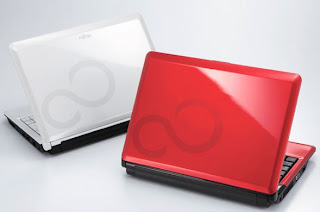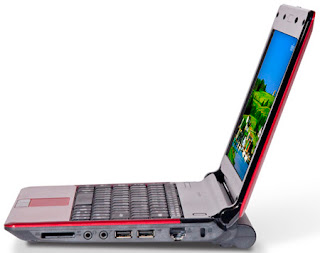Sunday, May 26, 2013
Fujitsu M2010
The M2010 is a new netbook to hit the market for Fujitsu, which is their first Atom-based model to date. Looks good and offers a good quality of construction, it is marketed as a "mini laptop" designed for casual users who want a small platform for surfing the Web or check e-mail. In this test, we examine all aspects of the M2010, to help you know if this netbook is right for you.
From the beginning, Fujitsu made a nice netbook. M2010 is a great shiny metallic red paint and off the shiny piano black plastic around the top of the keyboard and screen. I truly believe that Fujitsu has taken a step back and think before they came up with the launch netbook in a saturated market ... and found some interesting ways to make it stand out. Whatever the approach we took, it worked.
 |
Fujitsu M2010 |
Build quality is excellent, squeaks and creaks around the frame, and only minor flex large plastic surfaces. Even the screen hinges feel good with good power when the swivel screen and a very smooth action when moving. At the bottom of the notebook, we find the standard "We Fujitsu" in the location of the processor, which limits the amount of heat can be transferred in the legs when used on your lap. This is the norm in Fujitsu laptops Ive ever seen.
Access to internal components is managed by a single panel at the bottom of the laptop, but it only allows you to replace the wireless card and system memory. The hard drive will require further removal of ... something the average user may not want to do. However, it was probably a bad choice, because the memory and storage is the only area of expansion and modernization for netbook users.
 |
Fujitsu M2010 |
Screen and speakers
The glossy screen of the M2010 is very similar, as is the case with many netbook LED-backlit display. The colors are rich and vibrant, with excellent contrast and deep blacks. Maximum levels of brightness have been great to see in bright light conditions of the office, with the right configuration preferred by 50%. Check the angle on average, with the colors start to invest 20 degrees forward or backward. Horizontal viewing angles were much better, extending to the screen bezel and reflection began to obstruct the view of the panel.
Average heart rate compared to a netbook speakers, and below average compared to most laptops. Peak volume levels were fine to listen to a small room, but do not have much power to fill the chamber wall. Bass and midrange were not only higher frequencies to come. Headphones should really enjoy music or movies.
Keyboard and touchpad
The keyboard is the main area that I feel Fujitsu should have spent more time in development. Compared to almost every netbook on the market today, it is one of the smaller keyboard layout that feels very tight. As HP set the trend for one of the best laptop keyboards, manufacturers like ASUS has followed a similar path, expand the keyboard to make it as wide as possible to the chassis. Fujitsu holds a wide edge around the keyboard, much like the glossy red, but does not allow such a large writing surface. Despite the small size of the keyboard feels very good. The support is excellent, with just a hint of flex under heavy pressure to write. Individual key action is smooth, with very little swing key when you try to move top of the key around. Noise is minimal as you type, with a soft large not click when each key is pressed.
M2010 has a Synaptics touchpad with smaller smooth finish. During the tests, it was easy to use, without perceptible delay (a configuration of a few). Initially, we found the touchpad to the coast, after they put their fingers on the surface, he felt very similar to the touchpad lag. We found Synaptics feature called "Momentum" was used, and moving off again on the trackpad feels a lot nicer. The trackpad offers multi-touch features such as flick, pinch, and ChiralRotate, used to rotate the selected object 90 degrees. It is not an option for two finger scroll found. The touchpad buttons are setup button with the swing, which is flexible enough that the two buttons can be pressed simultaneously. Feedback is down is minimal, engaged in a strong shot.
 |
Fujitsu M2010 |
Ports and Features
Port Selection M2010 is average compared to most of the netbook market, three USB ports, VGA, headphone / microphone and SDHC Multi-Card Reader, and the LAN. Fujitsu is also a Kensington lock slot if you feel that you need to securely connect the netbook and unattended.
Our Fujitsu M2010 has the following specifications:
Operating System: Windows XP Home
Processor: Intel Atom N270 processor at 1.60 GHz (533 MHz FSB, 512 KB cache)
* Memory: 1GB DDR2 SDRAM PC2-6400
* Internal memory: 160 GB 5400 rpm SATA HDD
* Display: 10.1 inch LED backlit WSVGA (1024x576)
* Graphics: Intel GMA 950
* Wireless: Atheros 802.11b / g, Bluetooth 2.1 + EDR
* Expansion: 4-in-1 Media Card Reader
* Ports and Connectors: (3) USB 2.0 ports, VGA, power connector, RJ-45/ethernet, headphone / line out, stereo microphone, 1.3 megapixel camera
* Dimensions (H x W x D): 10.2 "x 7.4" x 1.3 "
Weight: 2 pounds 8.8 ounces (3 pounds 5.2 ounces with adapter).
* Food: 3-cell Lithium-Ion (10.8V, 2.4Ah, 26Wh)
* Warranty: One year international warranty
* MSRP: $ 449